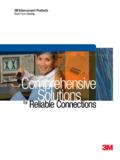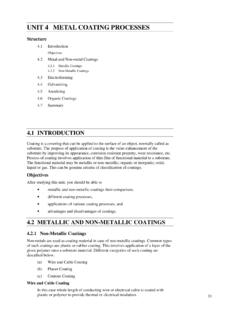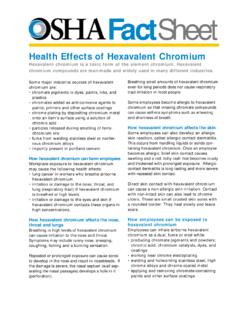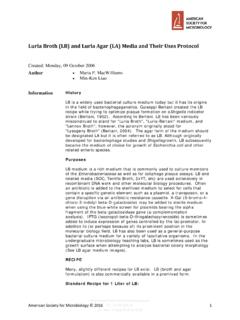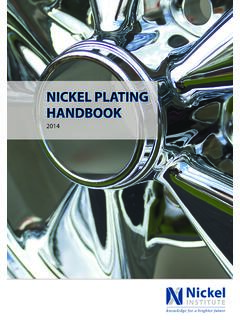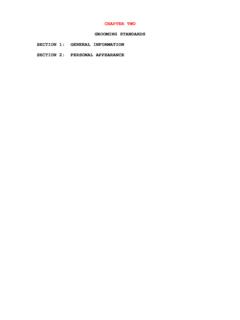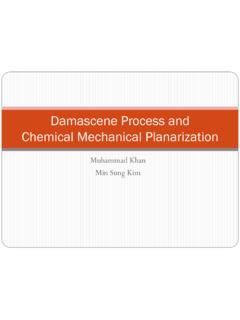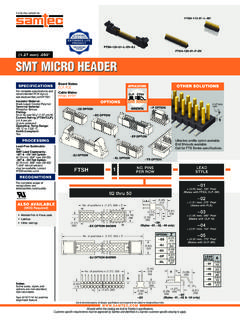Transcription of Preparation of calcium competent Escherichia coli and heat ...
1 Vol. 1:22-25. Preparation of calcium competent Escherichia coli and heat-shock transformation Chang, Angela Y., Chau, Vivian WY., Landas, Julius A., Pang, Yvonne Department of Microbiology and Immunology, University of British Columbia calcium chloride heat-shock transformation is a powerful molecular biology technique used to introduce foreign DNA into a host cell. The concept of the technique is to render cells competent using CaCl2 to allow for introduction of plasmid. Plasmids usually contain the gene(s) of interest in addition to selection and/or antibiotic resistance markers. The Hanahan or calcium chloride method is used to generate chemically competent cells. Heat-shocking facilitates the transport of plasmid into the competent cell.
2 Transformed cells will allow for downstream applications such as plasmid amplification or protein expression. This methods paper will outline the protocol for the Preparation of calcium competent Escherichia coli using the Hanahan method and heat-shock transformation of calcium competent Escherichia coli. INTRODUCTION MATERIALS AND EQUIPMENT. The process of calcium chloride heat-shock transformation encourages bacterial cells to uptake Materials: DNA from the surrounding environment. The exact competent cell Preparation : mechanism of how this process works is still largely 1mL of overnight Escherichia coli (E. unknown, but there are hypotheses on the different coli) culture aspects of the procedure.
3 The role of calcium ions in the 100mL of CaCl2 (ice cold). cell suspension is hypothesized to be a cation bridge 20mL of CaCl2 with 15% glycerol between the negative charges on phosphorylated lipid solution (ice cold). A in lipopolysaccharide (LPS), and the phosphate 100mL of fresh lysogeny broth (LB). backbone of DNA (1, 2). The ice-cold CaCl2 solution media facilitates binding of DNA to the surface of the cell, Heat-shock transformation: which then enters the cell after a short period of heat- 1pg - 100ng plasmid DNA (1-5uL). shock (3). Cells that are successfully transformed are 1mL of pre-warmed LB media or SOC. usually identified by selection or screening markers media at 37 C. such as drug resistance or fluorescence (4).
4 This LB agar plates (with appropriate technique is commonly used to transform cells with reagent for selective or screening). plasmids for various purposes like recombinant protein Ice expression, cloning, and long term storage of the plasmids. Equipment: 37 C shaking incubator Key words: CaCl2 method, Hanahan's method, 42 C water bath heat-shock transformation, competent cell, E. coli, Spectrophotometer plasmid, DNA, molecular biology Submitted: May 1, 2017 Accepted: July 1, 2017. Published: July 13, 2017. June 2017 Volume 1 Undergraduate Methods Paper 22. PROTOCOL METHODS. A1. Buffer A. CaCl2 Buffers Preparation Preparation (1-2hrs). Day 1. 1M CaCl2 (stock solution, 10x working concentration). B1.
5 Overnight culture Weigh out of anhydrous CaCl2. (< 1hr Preparation , 12- 16hrs incubation) Add to 80mL of dH2O. Mix solution until CaCl2 is fully dissolved Top up to 100mL. Filter sterilize through a m pore C1. Subculturing CaCl2 (working solution). overnight culture (3- 4hrs) Add 10mL of 1M CaCl2 to 90mL of dH2O for a Day 2 1:10 dilution C2. calcium chloride Filter sterilize through a m pore wash ( ). CaCl2 + 15% glycerol (working solution). Mix 6mL 1M CaCl2 with 9mL sterile glycerol and 45mL dH2O. D1. Heat shock transformation ( ) B. Overnight Culture(s). Day 3 D2. plating (1-3hrs). Inoculate 1mL of LB with E. coli D3. Incubation (12- Place in shaking incubator at 37 C and 200rpm 16hrs) Incubate for 12-16 hours C.
6 Generation of competent Cells (CaCl2 wash). Subculturing overnight culture: Day 4 E1. Plate observations Add 1mL of overnight culture to 99mL of fresh LB (1:100 dilution, no antibiotics). Shake incubate at 37 C and 200rpm for 3-4. hours or until OD reaches Buffers and overnight cultures are prepared the day before the experiment. Subculture the overnight the next day and allow for 3-4 hours of growth. Pellet the CaCl2 wash: subculture and wash with CaCl2. Following generation Ensure that all reagents (CaCl2 solutions , of competent cells, use the heat-shock method to Oakridge tubes, centrifuge) are ice-cold or at introduce plasmid DNA into cells. Plate the 4 C. transformed cells on the appropriate LB plates Separate culture into multiple Oakridge tubes supplemented with the reagent for selection or Place on ice for 20 minutes screening.
7 Incubate the plates overnight and record Centrifuge at 4 C at 4000rpm for 10 minutes colony counts the next day. Discard the supernatant by tipping tubes over a discard bin and then aspirating any remaining media June 2017 Volume 1 Undergraduate Methods Paper 23. Resuspend each pellet with 20mL ice-cold Perform another transformation to which CaCl2, incubate on ice for 30 minutes plasmid DNA is not added to act as a negative Centrifuge at 4 C at 4000rpm for 10 minutes control. Discard the supernatant and combine pellets by Transform 1ng of target plasmid to check resuspending in 5mL ice-cold CaCl2 with competent cell viability, calculate 15% glycerol transformation efficiency, and verify the antibiotic resistance of the plasmid.
8 Use for downstream transformation or store in -80 C freezer ACKNOWLEDGEMENTS. D. Heat-shock transformation We would like to thank Dr. David Oliver and Angela Lin for their guidance and suggestions throughout the experiment. Heat-shock: Thaw competent cells on ice REFERENCES. Add 1-5 l (10pg-100ng) of plasmid (do not 1. DeLucia, AM, Six, DA, Caughlan, RE, Gee, P, Hunt, I, exceed 5 L for a 50 L cell aliquot). Lam, JS, Dean, CR. 2011. Lipopolysaccharide (LPS) Inner- Incubate on ice for 30 minutes Core Phosphates Are Required for Complete LPS. Heat-shock by placing in 42 C water bath for Synthesis and Transport to the Outer Membrane in exactly 30 seconds Pseudomonas aeruginosa PAO1. Mbio. 2:e00142-11.
9 Place cells on ice for 2 minutes 2. Liu, I, Liu, M, Shergill, K. 2006. The Effect of Spheroplast Formation on the Transformation Efficiency in Escherichia Add 1mL pre-warmed LB or SOC medium coli DH5 . Jemi. 9:81-85. Shake incubate 37oC, 200rpm, 1 hour for 3. Bergmans, HE, van Die, , , Hoekstra, WP. 1981. outgrowth Transformation in Escherichia coli: stages in the process. J. Bacteriol. 146:564-570. plating and incubation: 4. Jang, C, Magnuson, T. 2013. A Novel Selection Marker for Efficient DNA Cloning and Recombineering in E. coli. Plos Spread plate 1:10 and 1:100 dilutions of the One. 8:e57075. outgrowth cultures on warm selective and/or screening plates ( Ampicillin and/or X-gal if required). Incubate at 37 C for 12-16 hours Plate observations: Inspect plates for isolated colonies ANTICIPATED RESULTS AND CONTROLS.
10 Anticipated results: No colonies appear on the plate. A countable number of colonies (30-300. colonies) appear on the plate. Many colonies that are too numerous to count appear on the plate. Controls: Use a DNA Preparation that has been shown to give transformants in previous experiments to act as a positive control. June 2017 Volume 1 Undergraduate Methods Paper 24. TROUBLESHOOTING. Problem Explanation Solution Few or no Incorrect antibiotic or antibiotic Confirm usage of correct antibiotic and antibiotic transformants present concentration was used concentration Cells are not competent Transform a plasmid ( pUC19) and calculate the transformation efficiency of the competent cells. If the transformation efficiency is low, make a new batch of competent cells.
